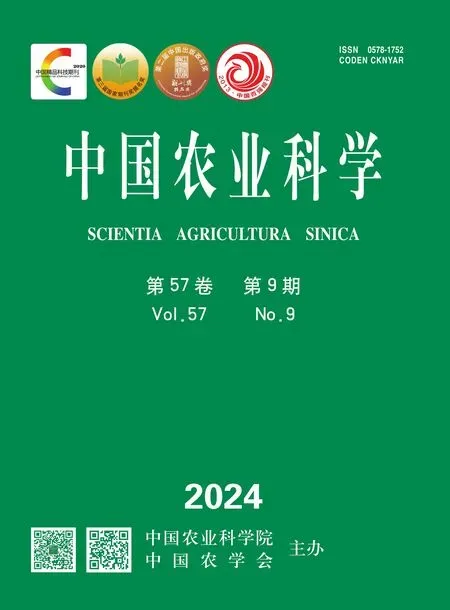不同施氮量对土壤团聚体碳氮含量及小麦产量的影响
韩潇杰,任志杰,李双静,田培培,卢素豪,马耕,王丽芳,马冬云,赵亚南,王晨阳
不同施氮量对土壤团聚体碳氮含量及小麦产量的影响

1河南农业大学农学院/国家小麦工程技术研究中心,郑州 450046;2河南农业大学资源与环境学院,郑州 450046
【目的】探究长期不同施氮量对土壤团聚体碳氮含量及小麦产量的影响,为合理施氮提供理论依据。【方法】基于设置在河南省许昌市张潘镇4个不同施氮水平11年定位试验,施氮量分别为0(N0)、180 kg·hm-2(N1)、240 kg·hm-2(N2)及300 kg·hm-2(N3),分析不同处理土壤碳氮含量、团聚体分布及其碳氮含量的变化,并探寻长期施氮对小麦产量及其构成的调控路径。【结果】随着施氮量增加,各土层土壤团聚体分布呈现大团聚体(>0.25 mm)向微团聚体(0.053—0.25 mm)和粉黏粒组分(<0.053 mm)转化的趋势,显著降低了团聚体平均重量直径(MWD)。土壤碳、氮含量在0—20 cm土层随施氮量增加而逐渐上升,20—40 cm土层呈先升高后降低趋势。与N0相比,0—20 cm土层各施氮处理土壤有机碳和全氮含量的平均增幅分别为13.1%—37.2%和19.4%—29.4%;20—40 cm土层的平均增幅分别为15.3%—32.2%和6.1%—29.3%。长期施氮处理显著提高了各粒级团聚体有机碳含量,与N0相比,施氮处理大团聚体有机碳平均含量提高31.6%—62.0%,微团聚体提高8.7%—61.2%,粉黏粒提高14.0%—81.7%。在0—20 cm土层,各粒级团聚体全氮含量亦随施氮量增加而增加,各施氮处理大团聚体、微团聚体和粉黏粒中全氮含量平均增幅分别为32.6%—51.0%、25.7%—35.9%和3.2%—9.7%,且均以N3处理最高。在20—40 cm土层,各粒级团聚体全氮含量随施氮量增加呈先升高后降低趋势,各施氮处理大团聚体、微团聚体和粉黏粒全氮含量平均增幅分别为17.6%—35.2%、11.7%—24.0%和1.1%—12.9%,且均以N1处理最高。研究结果还表明,长期施氮显著增加了小麦成穗数和穗粒数,进而提高了产量。与N0相比,N1、N2和N3处理分别提高小麦产量188.1%、177.3%和173.2%。相关分析与结构方程模型分析表明,小麦产量与土壤碳、氮含量及团聚体中碳、氮含量均呈显著正相关,长期施氮通过改变土壤及团聚体中碳、氮含量进而影响小麦产量。【结论】综上,长期合理施氮提高了土壤及团聚体中碳、氮含量,提升了土壤肥力,促进小麦增产。在本试验条件下以施氮量180 kg·hm-2时最优。
氮肥施用量;土壤团聚体;碳、氮含量;小麦产量
0 引言

1 材料与方法
1.1 试验地概况
长期定位试验始于2012年,采用小麦-玉米周年轮作模式。试验地位于河南省许昌市张潘镇(33°59′N,113°58′E),属温带季风气候,年均温为11.7 ℃,极端最高气温为41 ℃,极端最低气温为-12 ℃。多年平均降雨量642 mm,降水主要集中在7、8、9月。土壤类型为潮土,定位试验开始时,0—20 cm土层有机碳含量为13.04 g·kg-1,全氮含量为0.72 g·kg-1,全磷含量0.79 g·kg-1,全钾含量6.58 g·kg-1,速效磷含量22.36 mg·kg-1,速效钾含量157.61 mg·kg-1。试验调查年度小麦播前(2021年10月)0—20 cm土层养分状况见表1。

表1 2021年土壤养分状况
1.2 试验设计
定位试验采用随机区组设计,两季作物均设置4个施氮量处理:0(N0)、180 kg·hm-2(N1)、240 kg·hm-2(N2)和300 kg·hm-2(N3),小区面积110 m2(10 m×11 m),3次重复。小麦季施磷肥(P2O5)120 kg·hm-2、钾肥(K2O)75 kg·hm-2;玉米季施磷肥75 kg·hm-2、钾肥75 kg·hm-2。氮肥施用尿素(N含量 46%),磷肥施用重过磷酸钙,钾肥施用氯化钾。两季作物秸秆均粉碎还田,小麦季肥料于耕前撒施,然后翻耕整地,等行距条播,播量为150 kg·hm-2;玉米季肥料采用沟施方式。以小麦品种百农207和玉米品种登海678为试验材料。小麦每年10中旬播种,翌年6月中旬收获,田间管理按正常大田进行,小麦-拔节期灌溉1次。
1.3 测定项目及方法
1.3.1 土壤团聚体的筛分与碳氮含量的测定 于2021年10月小麦播种期前,采用5点取样法在每个小区按照“S”形使用土钻采集0—20和20—40 cm土层土壤,混合后装入自封袋带回实验室。将土壤进行风干后,挑去根系和植物残体等杂质,一部分研磨后过100目筛,用于测定土壤有机碳和全氮,一部分过4 mm筛,用于团聚体筛分。团聚体的筛分采用湿筛法[16],称取风干土50.0 g,放置于套筛上(套筛孔径自上而下分别为0.25 mm和0.053 mm),浸泡5 min后,2 min内上下匀速摆动50次,获得>0.25 mm的大团聚体、0.25—0.053 mm微团聚体和<0.053 mm粉黏粒组分。将各粒级团聚体组分在50℃下烘干后过100目筛,用于有机碳和全氮的测定。有机碳采用重铬酸钾-硫酸外加热法测定,全氮采用全自动凯氏定氮仪测定。
1.3.2 团聚体平均重量直径及其碳氮贡献率的计算 平均重量直径(MWD)的计算公式为:
MWD=∑=1x∑=1
式中,为团聚体粒级数;x为级团聚体的平均直径(mm);ω为级团聚体百分含量。
各级团聚体碳(氮)贡献率(%)=某一粒级团聚体碳(氮)含量×该粒级团聚体占重量的百分比/各粒级团聚体碳(氮)含量的总和[17]。
1.3.3 产量及其构成因素的测定 于成熟期对1 m双行中的穗数进行调查,并随机选取30穗测定穗粒数。每个小区选取4 m2(2 m×2 m)的样方进行人工收获,脱粒后测定含水量,用于产量和千粒重计算。
1.4 数据统计与分析
采用Excel 2019及SPSS 26进行数据统计分析,图片绘制采用Origin 2021进行,多重比较采用Duncan检验法,显著性水平为<0.05,结构方程模型使用软件AMOS进行绘制。
2 结果
2.1 施氮量对土壤团聚体分布的影响
由表2可知,长期施氮影响了土壤团聚体粒级分布。随施氮量的增加呈现出大团聚体向微团聚体和粉黏粒转化的趋势。在0—20 cm土层中,与N0相比,N1、N2和N3处理大团聚体组分重量占比显著降低31.1%、31.8%和34.1%,粉黏粒组分重量占比显著增加18.6%、23.0%和32.4%,微团聚体占比无显著变化。在20—40 cm土层中,与N0相比,N1、N2和N3处理大团聚体组分重量占比显著降低29.5%、44.1%和63.5%,粉黏粒组分重量占比显著增加16.1%、27.4%和40.9%,微团聚体未呈现显著变化。在长期不同施氮水平处理下,随着施氮量的增加,各土层团聚体平均重量直径均呈现显著下降的趋势。在0—20 cm土层,与N0相比,N1、N2和N3处理平均重量直径分别显著降低28.5%、29.2%和32.0%;在20—40 cm土层,分别显著降低25.7%、38.5%和55.0%。表明施氮促进大团聚体向小粒级团聚体转变,降低平均重量直径,导致土壤稳定性下降。

表2 长期不同施氮量下土壤团聚体质量百分比和平均重量直径
不同字母表示处理间差异显著(<0.05)。下同 Different letters meant significant difference among treatments at 0.05 level. The same below
2.2 施氮量对土壤有机碳和全氮的影响
由图1可知,0—20 cm土层中有机碳含量随施氮量增加呈上升趋势,与N0相比,N1、N2和N3处理的土壤有机碳含量分别增加了13.1%、15.7%和37.2%。 20—40 cm土层中N1处理有机碳含量高于其他处理,与N0相比,N1、N2和N3处理的土壤有机碳含量分别显著增加32.2%、15.3%和29.8%。0—20 cm土层中全氮含量随施氮量增加呈上升趋势,与N0相比,N1、N2和N3处理的土壤全氮含量分别增加19.4%、20.7%和29.4%。20—40 cm土层中N1处理土壤全氮含量高于其他处理,与N0相比,N1、N2和N3处理的土壤全氮含量分别增加29.3%、6.1%和8.5%。
2.3 施氮量对土壤团聚体有机碳分布特征的影响
由图2可知,在长期不同施氮条件下,不同粒级水稳定性团聚体有机碳含量表现为大团聚体>微团聚体>粉黏粒组分。在0—20 cm土层中,与N0相比,N1、N2和N3处理的大团聚体有机碳含量分别显著增加了39.5%、59.1%和62.0%;微团聚体有机碳含量分别显著增加了44.9%、61.2%和47.1%;粉黏粒有机碳含量分别显著增加了14.0%、15.5%和18.1%。在20—40 cm土层中,与N0相比,N1、N2和N3处理的大团聚体有机碳含量分别显著增加了31.6%、33.0%和43.2%;微团聚体有机碳含量分别增加了20.2%、8.7%和14.1%;粉黏粒有机碳含量分别显著增加了81.7%、42.8%和29.7%。由表3可知,长期不同施氮处理下微团聚体中有机碳对土壤总有机碳贡献率最大,为44.9%—60.5%。在0—20 cm土层,各粒级团聚体对土壤总有机碳贡献率表现为微团聚体>大团聚体>粉黏粒,20—40 cm土层,各粒级团聚体有机碳对土总有机碳贡献率表现为微团聚体>粉黏粒>大团聚体。
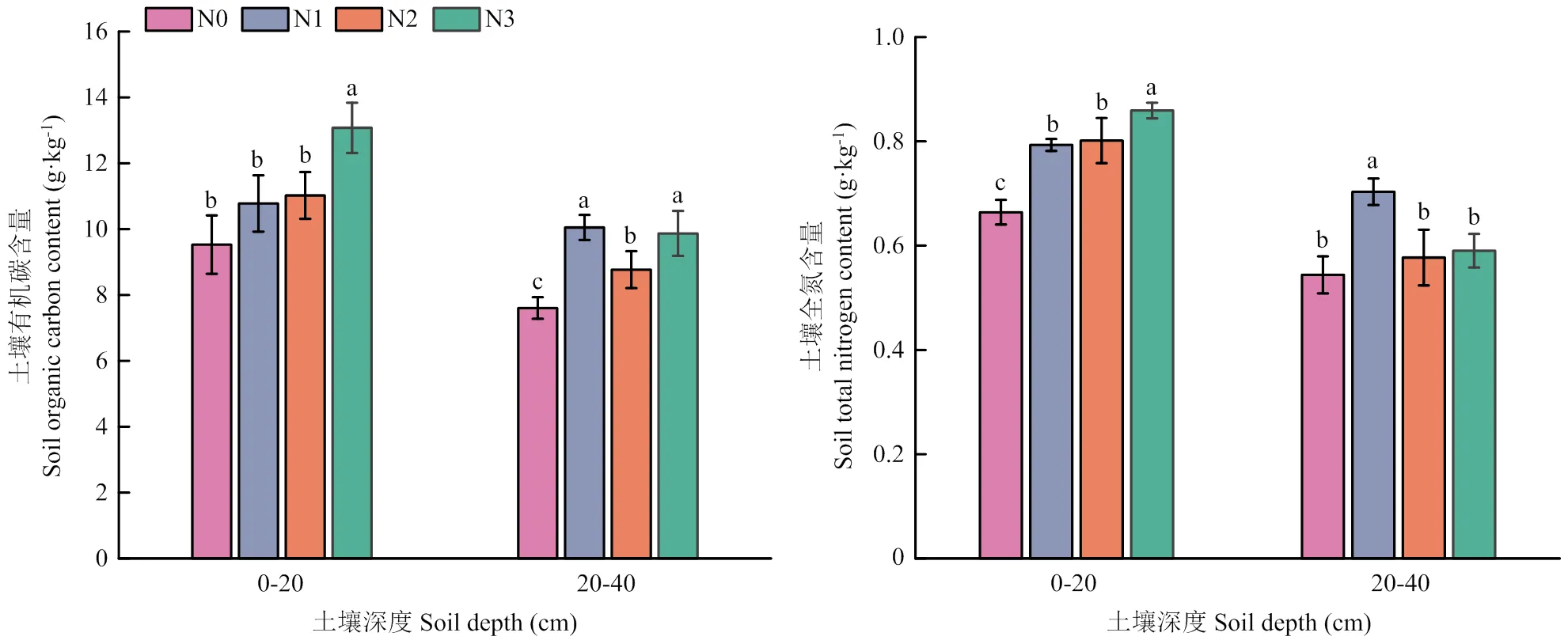
图1 长期不同施氮量下不同土层土壤有机碳和全氮含量
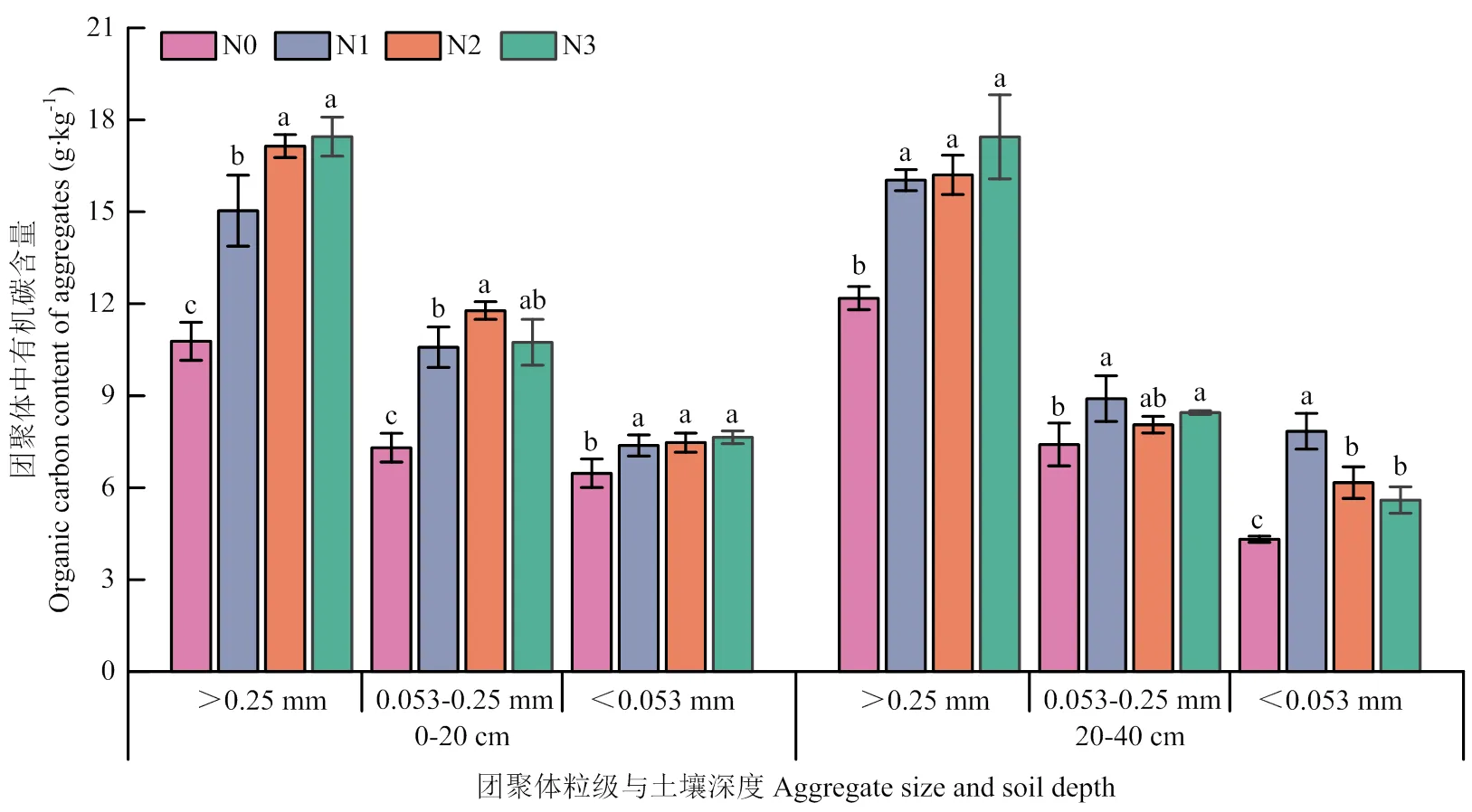
图2 长期不同施氮量下不同土层团聚体中有机碳含量
2.4 施氮量对土壤团聚体全氮分布特征的影响
由图3可知,在长期不同施氮量条件下,0—20 cm土层,随施氮量增加各粒级团聚体全氮含量呈上升趋势,各粒级团聚体全氮含量均以N3处理最高。与N0相比,N1、N2和N3处理的大团聚体全氮含量分别显著增加了32.6%、43.0%和51.0%;微团聚体全氮含量分别显著增加了25.7%、29.2%和35.9%;粉黏粒全氮含量分别增加了3.2%、8.9%和9.7%。在20—40 cm土层中,随施氮量增加各粒级团聚体全氮含量呈先升高后降低趋势,各粒级团聚体全氮含量均以N1处理最高。与N0相比,N1、N2和N3处理的大团聚体全氮含量分别显著增加了35.2%、17.6%和28.5%;微团聚体全氮含量分别显著增加了24.0%、11.7%和14.1%;粉黏粒全氮含量分别增加了12.9%、5.9%和1.1%。由表4可知,微团聚体氮对土壤全氮贡献率最高,为48.5%—60.9%。在0—40 cm土层中各粒级团聚体氮对土壤全氮贡献率表现为微团聚体>粉黏粒>大团聚体。
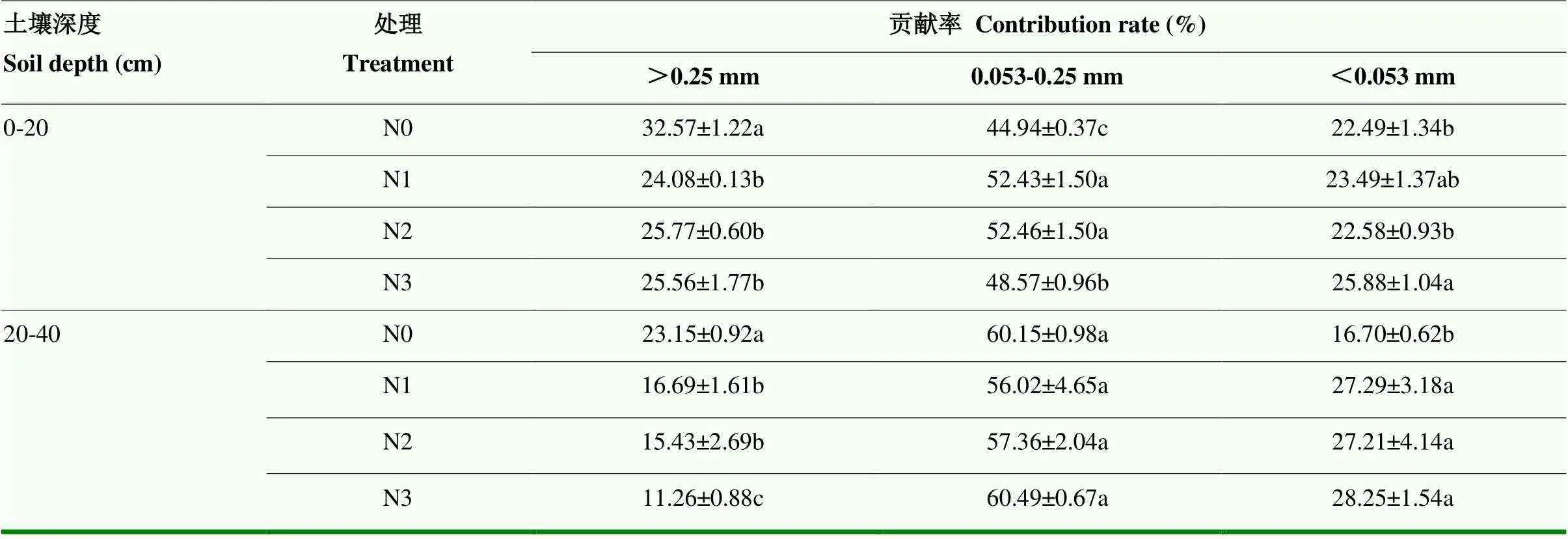
表3 长期不同施氮量下土壤各粒级团聚体有机碳对土壤总有机碳的贡献率

图3 长期不同施氮量下不同土层团聚体中全氮含量
2.5 施氮量对小麦产量及产量构成因素的影响
由表5可知,施氮量对穗数、穗粒数、粒重和产量都有显著的影响。与N0相比,各施氮处理显著增加了穗数(54.4%—74.0%)、穗粒数(18.0%— 20.3%),显著降低了千粒重(6.4%—9.0%)。与N0相比,N1、N2和N3处理的产量分别增加了188.1%、177.3%和173.2%,其中N1处理的产量最高,为11 149.9 kg·hm-2。
2.6 土壤及团聚体碳氮对小麦产量的贡献
土壤碳氮含量及各粒级团聚体碳氮含量与小麦产量均呈现正相关关系(图4和图5)。土壤有机碳含量、大团聚体有机碳含量、微团聚体有机碳含量和粉黏粒有机碳含量分别可以解释小麦产量57.2%、85.2%、75.3%和78.4%的变异。土壤全氮含量、大团聚体全氮含量、微团聚体全氮含量和粉黏粒全氮含量分别可以解释小麦产量75.3%、85.4%、82.7%和37.7% 的变异。其中,土壤全氮含量与小麦产量的相关性要高于土壤有机碳与小麦产量的相关性。在各级团聚体有机碳含量与小麦产量的关系中,其密切程度表现为大团聚体>粉黏粒>微团聚体。在各级团聚体全氮含量与小麦产量的关系中,其密切程度表现为大团聚体>微团聚体>粉黏粒。
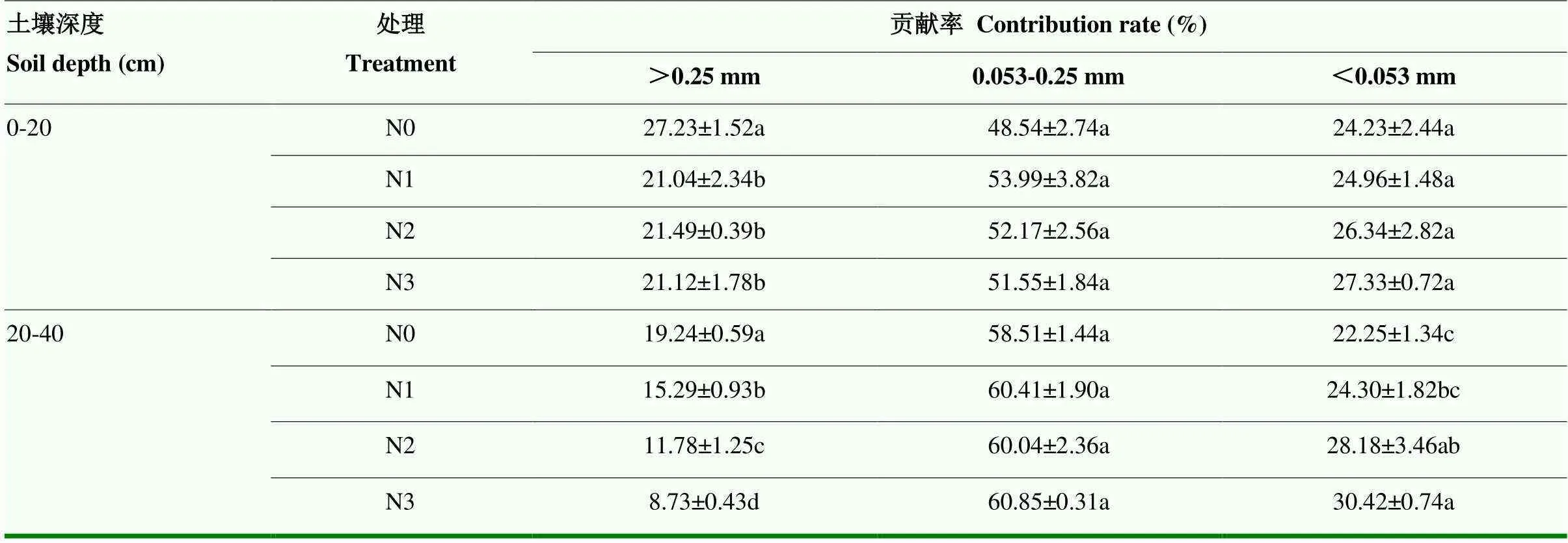
表4 长期不同施氮量下各粒级团聚体全氮对土壤全氮的贡献率
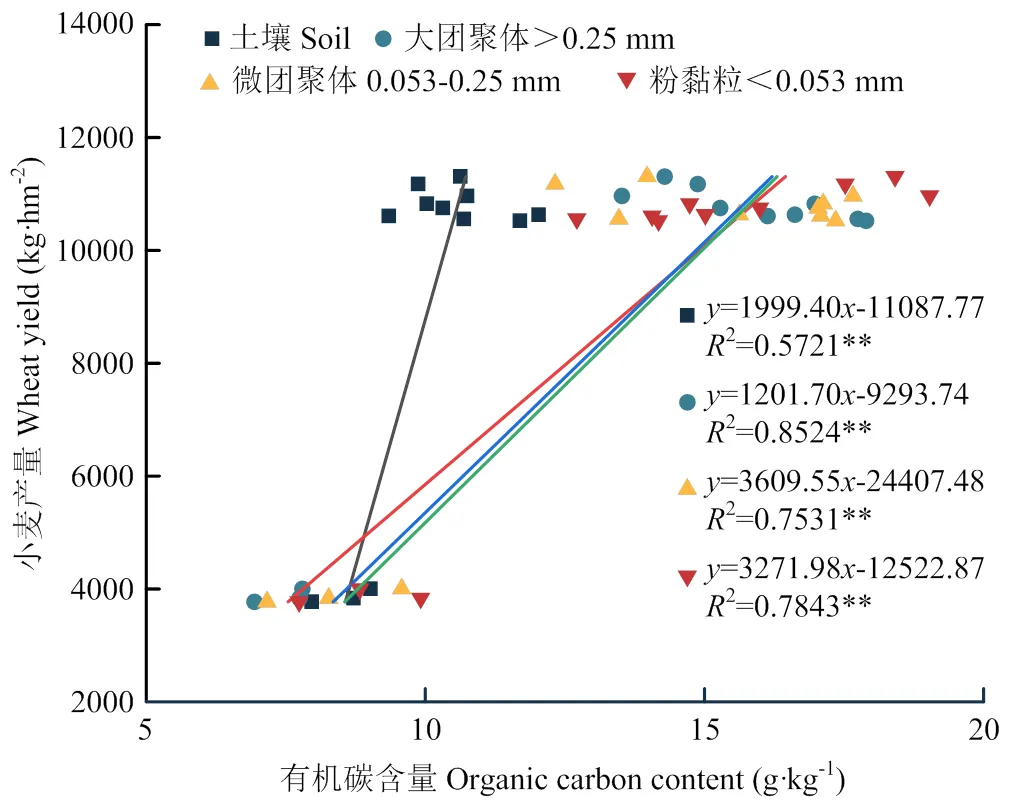
图4 小麦产量与土壤及团聚体中有机碳含量的关系
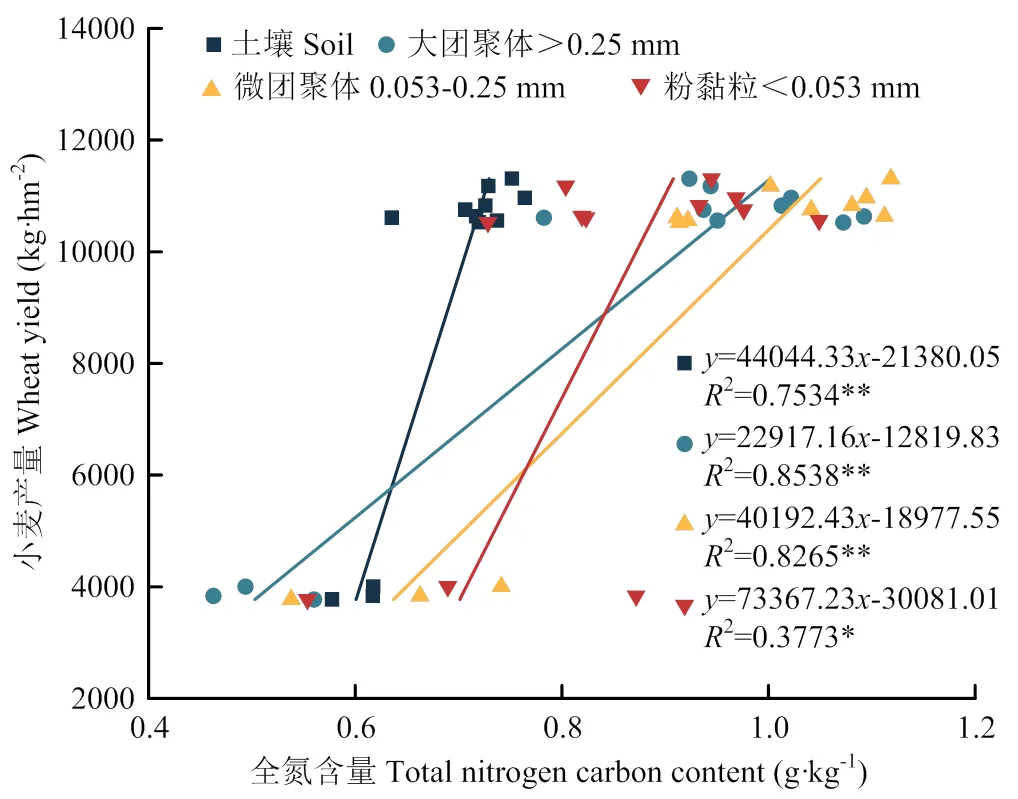
图5 小麦产量与土壤及团聚体中全氮含量的关系
为探究长期不同施氮量与土壤碳氮及产量的关联性,利用结构方程模型(SEM)对施氮量、团聚体碳氮含量、土壤碳氮含量及产量进行模拟,发现施氮对土壤和微团聚体碳氮含量均有正向的直接影响,路径系数分别为0.55(<0.05)、0.24(>0.05)和0.17(>0.05)、0.56(<0.05);微团聚体有机碳含量对土壤有机碳含量有正向的直接影响,路径系数为0.19(>0.05);微团聚体全氮含量对土壤全氮含量有极显著正向的直接影响,路径系数为0.84(<0.001);土壤有机质和全氮含量对产量有正向的直接影响,路径系数为0.26(<0.05)和0.26(>0.05);微团聚体有机质和全氮含量对产量有正向的直接影响,路径系数为0.42(<0.01)和0.13(>0.05);土壤全氮含量对土壤有机碳含量有正向的直接影响,路径系数为0.21(>0.05);微团聚体全氮含量对微团聚体有机碳含量有正向的直接影响,路径系数为0.76(<0.001)。间接因素施氮量通过影响土壤和微团聚体碳氮含量进而影响小麦产量。
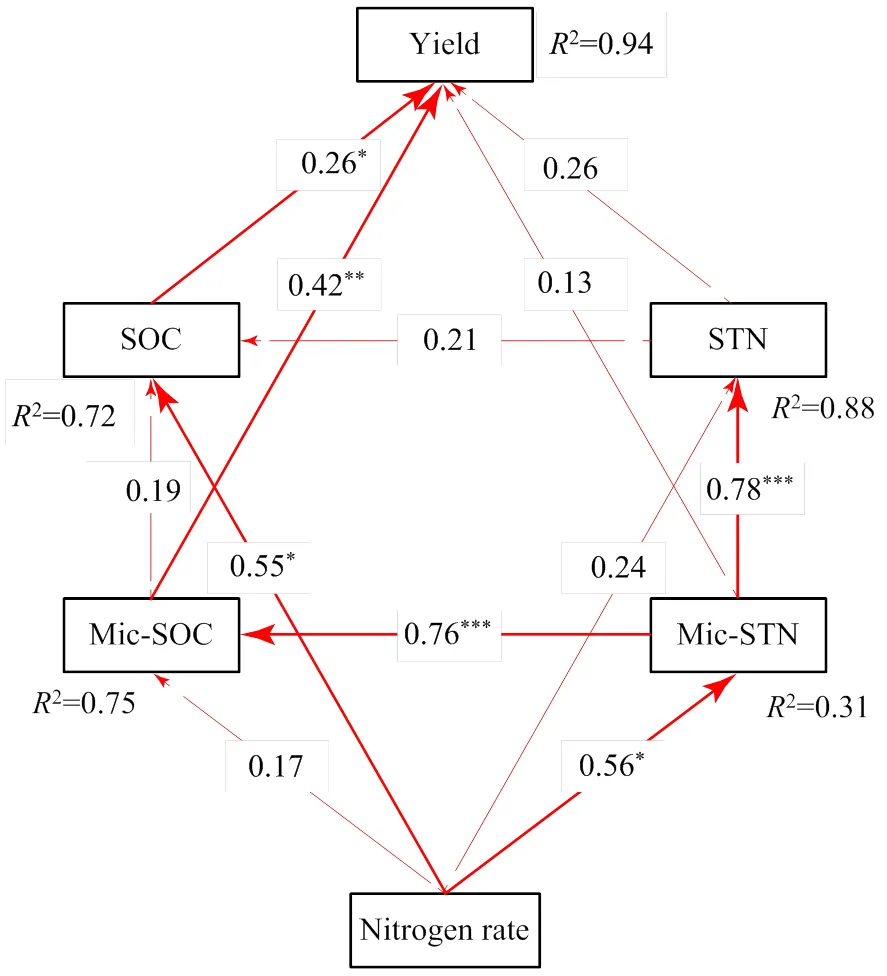
χ2/df=0.792,GFI=0.938,RMSEA=0.000
箭头旁的数字表示标准化路径系数,表示该变量所解释的方差,虚线表示不显著。*<0.05,**<0.01,***<0.001
The number adjacent to arrow line is standardized coefficients that shows the variance explained by the variable. The dotted line shows no significant correlation. *<0.05, **<0.01, ***<0.001
N rate:施氮量Nitrogen application rate;Mic-SOC:微团聚体有机碳含量Organic carbon content of micro-aggregates;Mic-TN:微团聚体全氮含量Total nitrogen content of micro-aggregates;SOC:土壤有机碳含量Soil organic carbon content;STN:土壤全氮含量Soil total nitrogen content;Yield:小麦产量Wheat yield
图6 施氮量影响土壤碳氮及产量的结构方程模型
Fig. 6 Structural equation model of effects of N rate on yield, soil C, and soil N
3 讨论
3.1 长期施氮对土壤团聚体组分及其碳氮含量的影响
土壤团聚体的组成与稳定性存在紧密联系,影响着土壤肥力和物理结构。在本试验条件下,施氮处理各土层土壤团聚体组分均以微团聚体为主,施氮显著降低了大团聚体重量占比,增加了粉黏粒重量占比(表1)。究其原因,可能一方面随施氮量增加引起土壤pH降低,加剧了土壤中可交换性阳离子总量的下降[18],而这些可交换性阳离子形成的无机胶结物质与土壤团聚体的形成及稳定性密切相关[19]。另一方面施氮会导致土壤真菌生物量下降,而真菌(如丛枝菌根真菌)生物量与土壤大团聚体形成密切相关[20]。因此长期施氮会促使大团聚体转化为较小的团聚体,且不利于微团聚体和粉黏粒团聚形成大团聚体。
土壤有机碳作为土壤肥力的重要评价指标,也是土壤质量和功能的核心[21]。本试验中,与不施氮相比,施氮显著提高了不同土层土壤有机碳含量,0—20 cm土层中增幅为13.1%—37.2%,20—40 cm土层中增幅为15.3%—32.2%,这与王慧等[22]的研究结果一致。施氮一方面通过增加植株的生物量,提高了植株凋零物以及根系残留物的量,进而增加了土壤的碳源[23];另一方面促进了微生物群落的生长,提高了土壤微生物群落碳源利用率[24],并有助于增强土壤中微生物残体的积累[25]。本试验还发现,施氮显著提高了各级团聚体有机碳含量,其中大团聚体有机碳增幅为31.6%— 62.0%。大团聚体作为土壤中有机碳固存的重要场所,在土壤碳素供给中发挥重要作用[26]。大团聚体有机碳含量显著增加,主要是植株凋落物进入土壤后,会被大团聚体所包裹,经过大团聚体中微生物的分解转化为颗粒有机物,颗粒有机物被矿物质及微生物所包裹,进而形成对有机碳的物理保护作用[27]。陈秋雨[28]的研究表明,长期施氮下土壤团聚体的有机碳含量表现为大团聚体>微团聚体>粉黏粒,即随施氮量的增加,粉黏粒中有机碳首先达到饱和,其次是微团聚体,最后是大团聚体,这与本试验结论一致。这可能是因为不同粒级团聚体的养分固存能力和物理保护能力存在差异[29],大团聚体能力强于微团聚体和粉黏粒,因此当微团聚体和粉黏粒达到饱和时,继续增加有机碳输入不能被固存,而大团聚体能持续固存有机碳。在本试验中,施氮不仅会影响土壤有机碳含量,同时影响各级团聚体有机碳含量。阮文亮等[30]研究表明,施氮显著降低了各级团聚体有机碳含量,这与本试验的结果不同。这可能是因为本试验为11年长期定位试验,土壤团聚体养分变化趋于稳定,而短期向土壤输入大量氮,会导致土壤C/N比下降,促进土壤微生物增殖,提高土壤有机碳矿化速率[31]。
氮素作为植物生长发育所必需的大量元素之一,土壤中全氮含量影响着土壤生产力[32]。土壤中碳与氮含量存在显著的相关性[33]。在本试验中,随施氮量增加土壤全氮含量的变化趋势与土壤有机碳含量趋于一致。在0—20 cm土层中土壤全氮含量增幅为19.4%— 29.4%,在20—40 cm土层中增幅为6.1%— 29.3%。与不施氮相比,施氮显著增加大团聚体和微团聚体全氮含量,增幅分别为17.6%—51.0%和11.7%—35.9%,这与曹寒冰等[34]的研究结果一致,不同施肥方式能够显著提高大团聚体中的全氮含量,而对粉黏粒没有显著的影响。这可能与团聚体养分固存能力有关。在0—20 cm土层各团聚体全氮含量表现为N3处理最高。而在20—40 cm土层表现为N1处理最高,N3处理全氮含量较N1处理下降5.0%—10.4%。这可能是由于增施氮肥促进了植株对土壤氮素的吸收[35];另一方面过量施氮(N3)造成20—40 cm土层大团聚体占比显著下降,导致土壤氮素固存能力降低,同时还加剧土壤氮素矿化[36],提高土壤中反硝化微生物丰度,促进土壤反硝化作用[37],从而降低了土壤团聚体全氮含量。
3.2 长期施氮对小麦产量及其构成因素的调控路径
氮肥的施用对于小麦产量的提高具有极显著的效应,不同施氮量对于小麦产量的影响存在一定的差异[38-39]。本试验条件下,施氮显著提高了小麦穗数和穗粒数,以施氮量180 kg·hm-2(N1)时小麦产量最高,这与以往的试验结果一致[3,40-42]。以往多数研究证明,氮肥的施用能够显著提高小麦群体数量[43]、增加可育小花和小穗的数量[44],进而提高了穗数和穗粒数;而在小麦产量构成要素中穗数的贡献最大[45]。但籽粒灌浆的总营养物质有限,库容过度增加会导致粒重的降低。本研究表明,N1、N2和N3千粒重分别较N0下降了7.6%、6.4%和9.0%。
在本试验中,通过对土壤碳氮含量与小麦产量之间进行线性拟合,得出土壤碳氮含量与小麦产量间存在极显著相关关系。通过结构方程模型进行拟合,发现土壤碳氮含量对小麦产量呈正向的直接效应,这与以往的研究结果一致[46]。土壤有机碳为土壤微生物增殖提供了丰富的有机底物和适宜的生长环境,促进微生物活性[47]。土壤氮是影响微生物代谢的重要因素[48],适当地提高土壤碳氮含量增加了微生物群落多样性,进而加快养分周转,为作物提供更多可利用养分[49],最终提高作物产量。侯永坤[50]的研究发现,30—40 cm土层中有机碳和全氮含量对于小麦产量具有显著影响,而本试验N1处理20—40 cm土层土壤碳氮含量高于其他处理,这可能是导致N1处理小麦产量高于其他处理的重要原因。
在本试验中,大团聚体和微团聚体碳氮含量与小麦产量呈极显著正相关,微团聚体碳氮含量对小麦产量具有正向的直接效应,其中微团聚体有机碳含量具有极显著的正效应,微团聚体有机碳含量与产量之间关系最密切,这与曹寒冰等[34]研究结果一致。团聚体对土壤有机碳具有重要物理保护作用,随着施氮量的增加,大粒级团聚体向小粒级团聚体转化,显著提高了微团聚体的比例,与大团聚体中的颗粒有机物质相比,微团聚体中颗粒有机物质稳定性更高[51],从而更多的有机碳被保护[52],因此,在长期施氮作用下,微团聚体通过提高并稳定土壤中的有机碳,提高土壤肥力,形成良好的土壤环境并提高根系生物量,进而在提高小麦产量中发挥着重要的作用。
4 结论
4.1 长期施氮降低了土壤中大团聚体含量,增加了粉黏粒组分含量,各土层均以微团聚体为主;同时长期施氮提高了0—20和20—40 cm土层各组分团聚体碳氮含量,其中以微团聚体对土壤有机碳和全氮的贡献率最高。
4.2 小麦产量的提高主要是由于施氮显著提高了成穗数和穗粒数。结构方程模型分析表明,土壤和微团聚体的碳氮含量对小麦产量具有正向直接效应,长期合理施氮通过增加团聚体中碳氮含量,提升土壤肥力,最终实现小麦增产。
[1] 刘玉秀, 黄淑华, 王景琳, 张正茂. 小麦籽粒钙元素含量的研究进展. 作物学报, 2021, 47(2): 187-196.
LIU Y X, HUANG S H, WANG J L, ZHANG Z M. Research advance on calcium content in wheat grains. Acta Agronomica Sinica, 2021, 47(2): 187-196. (in Chinese)
[2] 朱统泉, 吴大付. 河南小麦生产现状分析. 陕西农业科学, 2014, 60(1): 78-81.
ZHU T Q, WU D F. Analysis of wheat production status in Henan Province. Shaanxi Journal of Agricultural Sciences, 2014, 60(1): 78-81. (in Chinese)
[3] 李雪萌, 杨梅, 秦保平, 李赛星, 郝倩倩, 石彩云, 张敏, 蔡瑞国, 杨敏. 施氮量对强筋小麦物质积累与籽粒产量的影响. 麦类作物学报, 2023, 43(5): 609-622.
LI X M, YANG M, QIN B P, LI S X, HAO Q Q, SHI C Y, ZHANG M, CAI R G, YANG M. Effect of nitrogen application rate on matter accumulation and grain yield of strong gluten wheat. Journal of Triticeae Crops, 2023, 43(5): 609-622. (in Chinese)
[4] 赵亚南, 徐霞, 黄玉芳, 孙笑梅, 叶优良. 河南省小麦、玉米氮肥需求及节氮潜力. 中国农业科学, 2018, 51(14): 2747-2757. doi: 10.3864/j.issn.0578-1752.2018.14.012.
ZHAO Y N, XU X, HUANG Y F, SUN X M, YE Y L. Nitrogen requirement and saving potential for wheat and maize in Henan Province. Scientia Agricultura Sinica, 2018, 51(14): 2747-2757. doi: 10.3864/j.issn.0578-1752.2018.14.012. (in Chinese)
[5] 娄庭, 龙怀玉, 杨丽娟, 陈宝鸿, 周水亮, 穆真. 在过量施氮农田中减氮和有机无机配施对土壤质量及作物产量的影响. 中国土壤与肥料, 2010(2): 11-15, 34.
LOU T, LONG H Y, YANG L J, CHEN B H, ZHOU S L, MU Z. The effect of fertilizer ratio and rate on soil quality and crop yields in the farmland of excessive use of nitrogenous fertilizers. Soil and Fertilizer Sciences in China, 2010(2): 11-15, 34. (in Chinese)
[6] 吴波, 张亚军. 氮肥施用量对冬小麦的影响. 现代农业, 2009(11): 19-20.
WU B, ZHANG Y J. Effect of nitrogen fertilizer application rate on winter wheat. Modern Agriculture, 2009(11): 19-20. (in Chinese)
[7] 丁永刚, 李福建, 王亚华, 汤小庆, 杜同庆, 朱敏, 李春燕, 朱新开, 丁锦峰, 郭文善. 稻茬小麦氮高效品种产量构成和群体质量特征. 作物学报, 2020, 46(4): 544-556.
DING Y G, LI F J, WANG Y H, TANG X Q, DU T Q, ZHU M, LI C Y, ZHU X K, DING J F, GUO W S. Characteristics of yield components and population quality in high-nitrogen- utilization wheat cultivars. Acta Agronomica Sinica, 2020, 46(4): 544-556. (in Chinese)
[8] 翟勇全, 马琨, 贾彪, 魏雪, 运彬媛, 马健祯, 张昊, 姬丽, 李稼润. 不同降水年型滴灌玉米土壤硝态氮分布、淋失量及氮素吸收利用特征. 中国生态农业学报 (中英文), 2023, 31(5): 765-775
ZHAI Y Q, MA K, JIA B, WEI X, YUN B Y, MA J Z, ZHANG H, JI L, LI J R. Soil nitrate-N distribution, leaching loss and nitrogen uptake and utilization of maize under drip irrigation in different precipitation years. Chinese Journal of Eco-Agriculture, 2023, 31(5): 765-775. (in Chinese)
[9] 陈津赛, 孙玮皓, 王广帅, Abubakar Sunusi Amin, 高阳. 不同施氮量对麦田土壤水稳性团聚体和N2O排放的影响. 应用生态学报, 2021, 32(11): 3961-3968.
CHEN J S, SUN W H, WANG G S, ABUBAKAR S A, GAO Y. Effects of different nitrogen application rates on soil water stable aggregates and N2O emission in winter wheat field. Chinese Journal of Applied Ecology, 2021, 32(11): 3961-3968. (in Chinese)
[10] 李彩霞, 陈津赛, 付媛媛, 韩其晟, 宁慧峰, 王广帅. 施氮和灌溉管理对麦田土壤团聚体组成及有机碳的影响. 灌溉排水学报, 2022, 41(12): 59-64, 80.
LI C X, CHEN J S, FU Y Y, HAN Q S, NING H F, WANG G S. Effects of nitrogen fertilization and irrigation on soil aggregation and soil organic carbon in winter wheat field. Journal of Irrigation and Drainage, 2022, 41(12): 59-64, 80. (in Chinese)
[11] 郭戎博, 李国栋, 潘梦雨, 郑险峰, 王朝辉, 何刚. 秸秆还田与施氮对耕层土壤有机碳储量、组分和团聚体的影响. 中国农业科学, 2023, 56(20): 4035-4048.doi: 10.3864/j.issn.0578-1752.2023.20.009.
GUO R B, LI G D, PAN M Y, ZHENG X F, WANG Z H, HE G. Effects of long-term straw return and nitrogen application rate on organic carbon storage, components and aggregates in cultivated layers. Scientia Agricultura Sinica, 2023, 56(20): 4035-4048. doi: 10.3864/j.issn.0578-1752.2023.20.009. (in Chinese)
[12] WANG F L, LIU Y, LIANG B, LIU J, ZONG H Y, GUO X H, WANG X X, SONG N N. Variations in soil aggregate distribution and associated organic carbon and nitrogen fractions in long-term continuous vegetable rotation soil by nitrogen fertilization and plastic film mulching. The Science of the Total Environment, 2022, 835: 155420.
[13] 杨家明, 胡健, 潘军晓, 彭逸飞, 魏春雪, 汪金松, 田大栓, 周青平. 氮添加对高寒草甸土壤团聚体分布及其碳氮含量的影响. 北京林业大学学报, 2022, 44(12): 102-110.
YANG J M, HU J, PAN J X, PENG Y F, WEI C X, WANG J S, TIAN D S, ZHOU Q P. Effects of nitrogen addition on soil aggregate distribution and carbon and nitrogen contents in alpine meadow. Journal of Beijing Forestry University, 2022, 44(12): 102-110. (in Chinese)
[14] WANG J J, SUN X, DU L N, SUN W L, WANG X L, GAAFAR A R Z, ZHANG P, CAI T, LIU T N, JIA Z K, CHEN X L, REN X L. Appropriate fertilization increases carbon and nitrogen sequestration and economic benefit for straw-incorporated upland farming. Geoderma, 2024, 441: 116743.
[15] 张宁. 河南省典型土壤生态系统服务功能及其价值评价研究[D]. 郑州: 河南农业大学, 2016.
ZHANG N. Study on the typical soil ecosystem services value in Henan Province[D]. Zhengzhou: Henan Agricultural University, 2016. ( in Chinese)
[16] SIX J, ELLIOTT E T, PAUSTIAN K, DORAN J W. Aggregation and soil organic matter accumulation in cultivated and native grassland soils. Soil Science Society of America Journal, 1998, 62(5): 1367-1377.
[17] CHENG Y T, XU G C, WANG X K, LI P, DANG X H, JIANG W T, MA T T, WANG B, GU F Y, LI Z B. Contribution of soil aggregate particle size to organic carbon and the effect of land use on its distribution in a typical small watershed on Loess Plateau, China. Ecological Indicators, 2023, 155: 110988.
[18] 姚俊红, 武俊男, 王呈玉, 崔炎田, 高云航, 孙嘉璐, 刘淑霞. 长期不同施氮量下黑土团聚体稳定性及有机碳含量的变化. 农业环境科学学报, 2024, 43(1): 102-110.
YAO J H, WU J N, WANG C Y, CUI Y T, GAO Y H, SUN J L, LIU S X. Changes in aggregates stability and organic carbon content of black soil following the use of different long-term nitrogen application rates. Journal of Agro-Environment Science, 2024, 43(1): 102-110. (in Chinese)
[19] ZHANG J, WEI D, ZHOU B K, ZHANG L J, HAO X Y, ZHAO S C, XU X P, HE P, ZHAO Y, QIU S J, ZHOU W. Responses of soil aggregation and aggregate-associated carbon and nitrogen in black soil to different long-term fertilization regimes. Soil and Tillage Research, 2021, 213: 105157.
[20] 谭文峰, 许运, 史志华, 蔡鹏, 黄巧云. 胶结物质驱动的土壤团聚体形成过程与稳定机制. 土壤学报, 2023, 60(5): 1297-1308.
TAN W F, XU Y, SHI Z H, CAI P, HUANG Q Y. The formation process and stabilization mechanism of soil aggregates driven by binding materials. Acta Pedologica Sinica, 2023, 60(5): 1297-1308. (in Chinese)
[21] 王楚涵, 刘菲, 高健永, 张慧芳, 谢英荷, 曹寒冰, 谢钧宇. 减氮覆膜下土壤有机碳组分含量的变化特征. 中国农业科学, 2022, 55(19): 3779-3790.doi: 10.3864/j.issn.0578-1752.2022.19.008.
WANG C H, LIU F, GAO J Y, ZHANG H F, XIE Y H, CAO H B, XIE J Y. The variation characteristics of soil organic carbon component content under nitrogen reduction and film mulching. Scientia Agricultura Sinica, 2022, 55(19): 3779-3790. doi: 10.3864/j.issn. 0578-1752.2022.19.008. (in Chinese)
[22] 王慧, 刘金山, 惠晓丽, 戴健, 王朝辉. 旱地土壤有机碳氮和供氮能力对长期不同氮肥用量的响应. 中国农业科学, 2016, 49(15): 2988-2998.doi: 10.3864/j.issn.0578-1752.2016.15.013.
WANG H, LIU J S, HUI X L, DAI J, WANG Z H. Responses of soil organic carbon, organic nitrogen and nitrogen supply capacity to long-term nitrogen fertilization practices in dryland soil. Scientia Agricultura Sinica, 2016, 49(15): 2988-2998. doi: 10.3864/j.issn. 0578-1752.2016.15.013. (in Chinese)
[23] 祁瑜, 黄永梅, 王艳, 赵杰, 张景慧. 施氮对几种草地植物生物量及其分配的影响. 生态学报, 2011, 31(18): 5121-5129.
QI Y, HUANG Y M, WANG Y, ZHAO J, ZHANG J H. Biomass and its allocation of four grassland species under different nitrogen levels. Acta Ecologica Sinica, 2011, 31(18): 5121-5129. (in Chinese)
[24] 夏雪, 谷洁, 车升国, 高华, 秦清军. 施氮水平对塿土微生物群落和酶活性的影响. 中国农业科学, 2011, 44(8): 1618-1627. doi: 10.3864/j.issn.0578-1752.2011.08.010.
XIA X, GU J, CHE S G, GAO H, QIN Q J. Effects of nitrogen application rates on microbial community and enzyme activities in Lou soil. Scientia Agricultura Sinica, 2011, 44(8): 1618-1627. doi: 10.3864/j.issn.0578-1752.2011.08.010. (in Chinese)
[25] HU Q Y, LIU T Q, DING H N, LI C F, YU M, LIU J, CAO C G. The effects of straw returning and nitrogen fertilizer application on soil labile organic carbon fractions and carbon pool management index in a rice–wheat rotation system. Pedobiologia, 2023, 101: 150913.
[26] WANG Y L, WU P N, QIAO Y B, LI Y M, LIU S M, GAO C K, LIU C S, SHAO J, YU H L, ZHAO Z H, GUAN X K, WEN P F, WANG T C. The potential for soil C sequestration and N fixation under different planting patterns depends on the carbon and nitrogen content and stability of soil aggregates. The Science of the Total Environment, 2023, 897: 165430.
[27] SIX J, ELLIOTT E T, PAUSTIAN K. Aggregate and soil organic matter dynamics under conventional and No-tillage systems. Soil Science Society of America Journal, 1999, 63(5): 1350-1358.
[28] 陈秋雨. 长期覆盖和施氮下塿土土壤质量演变及碳氮转化特征研究[D]. 杨凌: 西北农林科技大学, 2021.
CHEN Q Y. Evaluation on soil quality evolution and carbon and nitrogen transformation characteristics of Lou soil under long-term mulching and nitrogen application[D]. Yangling: Northwest A&F University, 2021. (in Chinese)
[29] KOOL D M, CHUNG H, TATE K R, ROSS D J, NEWTON P C D, SIX J. Hierarchical saturation of soil carbon pools near a natural CO2spring. Global Change Biology, 2007, 13(6): 1282-1293.
[30] 阮文亮, 彭松, 祝晓慧, 崔凯荣, 赵利强, 揭佳惠, 李瑞琦, 王建武, 田纪辉. 减量施氮与间作大豆对甜玉米土壤团聚体及有机碳含量的影响. 四川农业大学学报, 2023, 41(5): 811-819.
RUAN W L, PENG S, ZHU X H, CUI K R, ZHAO L Q, JIE J H, LI R Q, WANG J W, TIAN J H. Effects of nitrogen reduction and soybean intercropping on soil aggregates and organic carbon content of sweet maize. Journal of Sichuan Agricultural University, 2023, 41(5): 811-819. (in Chinese)
[31] 庞飞, 李志刚, 李健. 有机物料和氮添加对宁夏沙化土壤碳矿化的影响. 水土保持研究, 2018, 25(3): 75-80.
PANG F, LI Z G, LI J. Effects of incorporated organic materials with n fertilizer on soil carbon mineralization of desertified soil in Ningxia. Research of Soil and Water Conservation, 2018, 25(3): 75-80. (in Chinese)
[32] 向艳文, 郑圣先, 廖育林, 鲁艳红, 谢坚, 聂军. 长期施肥对红壤水稻土水稳性团聚体有机碳、氮分布与储量的影响. 中国农业科学, 2009, 42(7): 2415-2424. doi: 10.3864/j.issn.0578-1752.2009.07.021.
XIANG Y W, ZHENG S X, LIAO Y L, LU Y H, XIE J, NIE J. Effects of long-term fertilization on distribution and storage of organic carbon and nitrogen in water-stable aggregates of red paddy soil. Scientia Agricultura Sinica, 2009, 42(7): 2415-2424. doi: 10.3864/j.issn.0578- 1752.2009.07.021.(in Chinese)
[33] 董雪, 郝玉光, 辛智鸣, 段瑞兵, 李新乐, 刘芳. 科尔沁沙地4种典型灌木灌丛下土壤碳、氮、磷化学计量特征. 西北植物学报, 2019, 39(1): 164-172.
DONG X, HAO Y G, XIN Z M, DUAN R B, LI X L, LIU F. Stoichiometric characteristics of soil carbon, nitrogen and phosphorus of four typical shrubs in horqin sandy land. Acta Botanica Boreali- Occidentalia Sinica, 2019, 39(1): 164-172. (in Chinese)
[34] 曹寒冰, 谢钧宇, 强久次仁, 郭璐, 洪坚平, 荆耀栋, 孟会生. 施肥措施对复垦土壤团聚体碳氮含量和作物产量的影响. 农业工程学报, 2020, 36(18): 135-143.
CAO H B, XIE J Y, QIANG J, GUO L, HONG J P, JING Y D, MENG H S. Effects of fertilization regimes on carbon and nitrogen contents of aggregates and maize yield in reclaimed soils. Transactions of the Chinese Society of Agricultural Engineering, 2020, 36(18): 135-143. (in Chinese)
[35] 黄建华, 史永晖, 马庆国, 王蕾, 陈国庆.施氮量对夏玉米不同生长阶段氮素吸收及N2O排放的影响.山东农业科学, 2023, 55(3): 109-116.
HUANG J H, SHI Y H, MA Q G, WANG L, CHEN G Q. Effects of nitrogen application on nitrogen uptake and N2O emission of maize at different growth stages. Shandong Agricultural Sciences, 2023, 55(3): 109-116. (in Chinese)
[36] 刘金山, 戴健, 刘洋, 郭雄, 王朝辉. 过量施氮对旱地土壤碳、氮及供氮能力的影响. 植物营养与肥料学报, 2015, 21(1): 112-120.
LIU J S, DAI J, LIU Y, GUO X, WANG Z H. Effects of excessive nitrogen fertilization on soil organic carbon and nitrogen and nitrogen supply capacity in dryland. Journal of Plant Nutrition and Fertilizer, 2015, 21(1): 112-120. (in Chinese)
[37] 宋亚娜, 林智敏, 林艳. 氮肥对稻田土壤反硝化细菌群落结构和丰度的影响. 中国生态农业学报, 2012, 20(1): 7-12.
SONG Y N, LIN Z M, LIN Y. Response of denitrifying bacteria community structure and abundance to nitrogen in paddy fields. Chinese Journal of Eco-Agriculture, 2012, 20(1): 7-12. (in Chinese)
[38] 任开明, 杨文俊, 王犇, 樊永惠, 张文静, 马尚宇, 黄正来. 施氮量对稻茬弱筋小麦籽粒氮代谢及灌浆的影响. 核农学报, 2023, 37(3): 606-616.
REN K M, YANG W J, WANG B, FAN Y H, ZHANG W J, MA S Y, HUANG Z L. Effect of nitrogen application rate on grain nitrogen metabolism and grain filling of weak gluten wheat after rice. Journal of Nuclear Agricultural Sciences, 2023, 37(3): 606-616. (in Chinese)
[39] 傅晓艺, 何明琦, 赵彦坤, 张士昌, 单子龙, 韩然, 张铁石, 史占良. 长期定位施氮条件下种植密度对冬小麦石4366品质和氮肥利用的影响. 麦类作物学报, 2023, 43(2): 215-224.
FU X Y, HE M Q, ZHAO Y K, ZHANG S C, SHAN Z L, HAN R, ZHANG T S, SHI Z L. Effect of planting density on quality characteristics and nitrogen utilization of winter wheat Shi 4366 under long-term positioning nitrogen application. Journal of Triticeae Crops, 2023, 43(2): 215-224. (in Chinese)
[40] 王丽芳, 康娟, 马耕, 王家瑞, 申圆心, 刘世洁, 王晨阳. 农田施氮对冬小麦产量、根-冠氮素积累及其利用效率的影响. 麦类作物学报, 2021, 41(11): 1403-1408.
WANG L F, KANG J, MA G, WANG J R, SHEN Y X, LIU S J, WANG C Y. Effect of Nitrogen Application on yield, nitrogen accumulation and use efficiency in root-shoot of winter wheat. Journal of Triticeae Crops, 2021, 41(11): 1403-1408. (in Chinese)
[41] 张姗, 石祖梁, 杨四军, 顾克军, 戴廷波, 王飞, 李想, 孙仁华. 施氮和秸秆还田对晚播小麦养分平衡和产量的影响. 应用生态学报, 2015, 26(9): 2714-2720.
ZHANG S, SHI Z L, YANG S J, GU K J, DAI T B, WANG F, LI X, SUN R H. Effects of nitrogen application rates and straw returning on nutrient balance and grain yield of late sowing wheat in rice-wheat rotation. Chinese Journal of Applied Ecology, 2015, 26(9): 2714-2720. (in Chinese)
[42] 李俊志, 常旭虹, 王德梅, 王艳杰, 杨玉双, 赵广才. 施氮水平对不同强筋小麦品种产量和品质的影响. 作物杂志, 2023(3): 148-153.
LI J Z, CHANG X H, WANG D M, WANG Y J, YANG Y S, ZHAO G C. Effects of nitrogen application levels on yield and quality of different strong gluten wheat varieties. Crops, 2023(3): 148-153. (in Chinese)
[43] 王丽芳, 刘世洁, 康娟, 马耕, 王晨阳. 施氮对小麦根-冠及土壤碳氮特征的影响. 麦类作物学报, 2022, 42(4): 451-456.
WANG L F, LIU S J, KANG J, MA G, WANG C Y. Influence of nitrogen application on the carbon and nitrogen characteristics of root-shoot and soil in wheat filed. Journal of Triticeae Crops, 2022, 42(4): 451-456. (in Chinese)
[44] 李存东, 曹卫星, 张月辰, 严美春. 氮肥施用时期对小麦不同茎蘖位顶端发育的调控效应. 植物营养与肥料学报, 2001, 7(1): 17-22.
LI C D, CAO W X, ZHANG Y C, YAN M C. Effect of N fertilizer application on apex development of different tiller positions at different spike development stages. Plant Nutrition and Fertilizer Science, 2001, 7(1): 17-22. (in Chinese)
[45] 田纪春, 邓志英, 胡瑞波, 王延训. 不同类型超级小麦产量构成因素及籽粒产量的通径分析. 作物学报, 2006, 32(11): 1699-1705.
TIAN J C, DENG Z Y, HU R B, WANG Y X. Yield components of super wheat cultivars with different types and the path coefficient analysis on grain yield. Acta Agronomica Sinica, 2006, 32(11): 1699-1705. (in Chinese)
[46] REN Z J, HAN X J, FENG H X, WANG L F, MA G, LI J H, LV J J, TIAN W Z, HE X H, ZHAO Y N, WANG C Y. Long-term conservation tillage improves soil stoichiometry balance and crop productivity based on a 17-year experiment in a semi-arid area of Northern China. The Science of the Total Environment, 2024, 908: 168283.
[47] YANG H S, FANG C, MENG Y, DAI Y J, LIU J. Long-term ditch-buried straw return increases functionality of soil microbial communities. Catena, 2021, 202: 105316.
[48] HENNERON L, KARDOL P, WARDLE D A, CROS C, FONTAINE S. Rhizosphere control of soil nitrogen cycling: A key component of plant economic strategies. The New Phytologist, 2020, 228(4): 1269-1282.
[49] MA T T, YANG K, YANG L, ZHU Y, JIANG B Q, XIAO Z P, SHUAI K F, FANG M, GONG J, GU Z M, XIANG P H, LIU Y J, LI J. Different rotation years change the structure and diversity of microorganisms in the nitrogen cycle, affecting crop yield. Applied Soil Ecology, 2024, 193: 105123.
[50] 侯永坤. 不同耕作模式对土壤理化性质和冬小麦产量的影响[D]. 泰安: 山东农业大学, 2019.
HOU Y K. Effects of different tillage models on soil physicochemical properties and winter wheat yield[D]. Taian: Shandong Agricultural University, 2019. (in Chinese)
[51] BAI J S, ZHANG S Q, HUANG S M, XU X P, ZHAO S C, QIU S J, HE P, ZHOU W. Effects of the combined application of organic and chemical nitrogen fertilizer on soil aggregate carbon and nitrogen: A 30-year study. Journal of Integrative Agriculture, 2023, 22(11): 3517-3534.
[52] 马原, 迟美静, 张玉玲, 范庆峰, 虞娜, 邹洪涛. 黑土旱地改稻田土壤水稳性团聚体有机碳和全氮的变化特征. 中国农业科学, 2020, 53(8): 1594-1605. doi: 10.3864/j.issn.0578-1752.2020.08.009.
MA Y, CHI M J, ZHANG Y L, FAN Q F, YU N, ZOU H T. Change characteristics of organic carbon and total nitrogen in water-stable aggregate after conversion from upland to paddy field in black soil. Scientia Agricultura Sinica, 2020, 53(8): 1594-1605. doi: 10.3864/ j.issn.0578-1752.2020.08.009. (in Chinese)
Effects of Different Nitrogen Application Rates on Carbon and Nitrogen Content of Soil Aggregates and Wheat Yield
HAN XiaoJie1, REN ZhiJie2, LI ShuangJing1, TIAN PeiPei1, LU SuHao1, MA Geng1, WANG LiFang1, MA DongYun1, ZHAO YaNan2, WANG ChenYang1
1College of Agronomy, Henan Agricultural University/National Engineering Research Center for Wheat, Zhengzhou 450046;2College of Resources and Environment, Henan Agricultural University, Zhengzhou 450046
【Objective】The influence mechanism of varying nitrogen (N) rates on the carbon (C) and N content of soil aggregate, as well as wheat yield were investigated in this study, so as to provide a scientific basis for the rational application of N fertilizer.【Method】The 11-year experiment was conducted in Zhangpan Town, Xuchang City, Henan Province, with four different N levels, including 0 (N0), 180 kg·hm-2(N1), 240 kg·hm-2(N2), and 300 kg·hm-2(N3). The study systematically analyzed changes in soil carbon and nitrogen content, cluster distribution and their carbon and nitrogen content in different soil layers as a result of long-term N application, and investigated the regulatory pathways of long-term N application on wheat yield and its composition.【Result】There was a transformation in the composition of soil aggregates in every soil layer, specifically from larger macroaggregates (>0.25 mm) to microaggregates (0.25-0.053 mm) and silt and clay particles (<0.053 mm), as well as an increase in N rate. Additionally, the application of N resulted in a significant decrease in the mean weight diameter (MWD). As N application rates increase, the C and N content of the soil increased in the 0-20 cm layer, the C and N content of the soil in the 20-40 cm soil layer showed the trend to increase at first and then decrease. Compared with the N0 treatment, N application increased soil organic carbon (SOC) and soil total nitrogen (STN) content by 13.1%-37.2% and 19.4%-29.4% in the 0-20 cm layer and by 15.3%-32.2% and 6.1%-29.3% in the 20-40 cm layer, respectively. The N treatment significantly increased the SOC content of each particle size aggregates compared with N0 treatment, with the SOC content of macroaggregates increasing by 31.6%-62.0%, the SOC content of microaggregates increasing by 8.7%-61.2% and the SOC content of silt and clay increasing by 14.0%-81.7%. As N application rates increased, the STN content of the soil increased in the 0-20 cm layer. With the STN content of macroaggregates increasing by 32.6%-51.0%, the STN content of microaggregates increased by 25.7%-35.9% and the STN content of silt and clay increased by 3.2%-9.7%, the N3 treatment had the highest STN content of all particle size aggregates. In the 20-40 cm soil layer, the STN content of all particle size aggregates tended to increase at first and then decrease. With the STN content of macroaggregates increasing by 17.6%-35.2%, the STN content of microaggregates increased by 11.7%-24.0% and the STN content of silt and clay increased by 1.1%-12.9%, and the N1 treatment had the highest STN content of all particle size aggregates. The study results indicated that long-term nitrogen application had a significant impact on the spike number and grain number per spike in wheat, resulting in increased yield. Compared with the N0 treatment, the application of N1, N2, and N3 treatments resulted in a significant increase in wheat yield, with improvements of 188.1%, 177.3%, and 173.2%, respectively. The correlation and structural equation modelling analyses revealed a significant and positive correlation between wheat yield and soil carbon and nitrogen content, as well as carbon and nitrogen content in aggregates. Additionally, the long-term application of nitrogen was found to influence wheat yield formation by affecting carbon and nitrogen content in microaggregates.【Conclusion】In summary, the application of nitrogen over a long period of time raised the content of carbon and nitrogen in both soil and aggregates, enhanced soil fertility, ultimately promoting wheat yield. The optimal nitrogen application rate was 180 kg·hm-2under the condition of this experiment.
nitrogen application rates; soil aggregates; content of carbon and nitrogen; wheat yield

10.3864/j.issn.0578-1752.2024.09.011
2024-01-05;
2024-02-29
国家重点研发计划(2022YFD2300803)、河南省重大科技专项(221100110700)、河南省科技攻关项目(232102111022)
韩潇杰,E-mail:xiaojiehan523@163.com。通信作者王晨阳,E-mail:xmzxwang@163.com
(责任编辑 李云霞)

